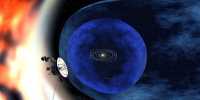Scientists identified the three fastest-spinning brown dwarfs ever discovered using data from NASA’s Spitzer Space Telescope. Brown dwarfs are cosmic in-betweeners, larger than most planets but not quite heavy enough to ignite like stars. They are thought to number in the billions in our galaxy, despite the fact that they are not as well known as stars and planets to most people.
The team that made the new speed measurements argue in a study published in the Astronomical Journal that these three rapid rotators may be approaching a spin speed limit for all brown dwarfs, beyond which they would break apart. The rapidly rotating brown dwarfs are all roughly the same size as Jupiter, but 40 to 70 times more massive. They each rotate once every hour, while the next-fastest known brown dwarfs spin once every 1.4 hours and Jupiter spins once every 10 hours. Based on their size, the largest of the three brown dwarfs travels at speeds of more than 60 miles per second (100 kilometers per second), or approximately 220,000 miles per hour (360,000 kilometers per hour).
Spitzer data was used to calculate the speeds. Spitzer was retired by NASA in January 2020. (The brown dwarfs were discovered by the ground-based Two Micron All Sky Survey, or 2MASS, which was in operation from 1989 to 2001.) The team then used the ground-based Gemini North and Magellan telescopes to confirm their unusual findings.
Using data from NASA’s Spitzer Space Telescope, scientists have identified the three fastest-spinning brown dwarfs ever found.
Brown dwarfs, like stars and planets, start spinning as soon as they form. They spin faster as they cool down and contract, similar to how a spinning ice skater draws her arms into her body. The spin rates of about 80 brown dwarfs have been measured, and they range from less than two hours (including the three new entries) to tens of hours.
With so much variation in brown dwarf speeds already measured, the authors of the new study were surprised to discover that the three fastest brown dwarfs ever discovered have nearly the same spin rate (about one full rotation per hour) as each other. This cannot be attributed to the brown dwarfs forming together or being at the same stage of development because they are physically distinct: one is a warm brown dwarf, one is a cold brown dwarf, and the other falls somewhere in between. Because brown dwarfs cool as they age, the temperature differences indicate that these brown dwarfs are of varying ages.
The authors aren’t chalking this up to coincidence. They think the members of the speedy trio have all reached a spin speed limit, beyond which a brown dwarf could break apart.
All rotating objects produce centripetal force, which increases as the object spins faster. This force can threaten to throw riders from their seats on a carnival ride; in stars and planets, it can tear the object apart. A spinning object will frequently begin to bulge around its midsection as it deforms under pressure before breaking apart. This is referred to as oblation by scientists. Saturn, like Jupiter, rotates once every ten hours and has discernible oblation. According to the paper’s authors, the brown dwarfs have similar degrees of oblation based on their known characteristics.

Reaching the Speed Limit
Given that brown dwarfs tend to accelerate with age, are these objects frequently exceeding their spin speed limit and being torn apart? Other rotating cosmic objects, such as stars, have natural braking mechanisms that prevent them from destroying themselves. It is unknown whether similar mechanisms exist in brown dwarfs.
“It would be pretty spectacular to find a brown dwarf rotating so fast that it is tossing its atmosphere out into space,” said Megan Tannock, a Ph.D. student at Western University in London, Ontario, and the study’s lead author. “However, we have yet to discover such a thing. That must imply that either something is slowing the brown dwarfs down before they reach that extreme, or that they are incapable of reaching that speed in the first place. The findings of our paper support some kind of rotation rate limit, but we don’t know why.”
Any object’s maximum spin rate is determined not only by its total mass but also by how that mass is distributed. That is why, when very fast spin rates are involved, understanding the interior structure of a brown dwarf becomes increasingly important: The material inside most likely shifts and deforms, altering how fast the object can spin. Brown dwarfs, like gas planets Jupiter and Saturn, are mostly made up of hydrogen and helium.
They are, however, significantly denser than most giant planets. Scientists believe that the hydrogen in the core of a brown dwarf is subjected to such high pressures that it begins to behave like a metal rather than an inert gas: It has conducting electrons that float freely, similar to a copper conductor. This alters how heat is conducted through the interior, and with such high spin rates, it may also alter how mass is distributed within an astronomical object.
“This state of hydrogen, or any gas under such extreme pressure, is still very enigmatic,” said Stanimir Metchev, co-author of the paper and Canada Research Chair in Extrasolar Planets at Western University’s Institute for Earth and Space Exploration. “Reproducing this state of matter is extremely difficult, even in the most advanced high-pressure physics laboratories.”
Physicists create models of what brown dwarf interiors should look like and how they should behave under extreme conditions using observations, laboratory data, and mathematics. However, current models predict that the maximum brown dwarf spin speed should be 50% to 80% faster than the one-hour rotation period described in the new study.
“It is possible that these theories do not yet have the complete picture,” Metchev said. “Some unappreciated factor may be at work that prevents the brown dwarf from spinning faster.” Additional observations and theoretical work may yet reveal whether brown dwarfs have a braking mechanism that prevents them from self-destruction and whether there are brown dwarfs spinning even faster in the dark.
Spitzer mission operations were managed by NASA’s Jet Propulsion Laboratory, a division of Caltech, for NASA’s Science Mission Directorate in Washington. The Spitzer Science Center at IPAC at Caltech was where the science was done. Lockheed Martin Space in Littleton, Colorado was in charge of spacecraft operations. The Spitzer data archive is kept at the Infrared Science Archive at Caltech’s IPAC in Pasadena, California. The International Gemini Observatory is a NOIRLab Program of the National Science Foundation.
















